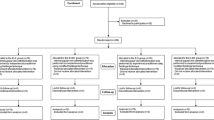Abstract
Objective
Our goal was to improve placement success rates for peripheral arterial line (PAL) placements by introducing an ultrasound-guided (USg) approach. Our aim was to maintain success rates over 70% within 18 months.
Study design
Interventions included development of a training curriculum, and procedure standardization. Among 302 patients, 115 underwent USg catheter placement; the traditional method was used in 187 patients. Outcome measures were first-attempt and overall success rates. Process measures were proportion of PALs placed under US guidance, trainer availability, and trainee sign-off. Line complications were balancing measures. Statistical process control charts were used to monitor metrics.
Results
Sustained improvement was seen with the USg approach. The USg approach had first and overall attempt success by the trainers (i.e., independent users) of 83.7% (77/92) and 96.5% (111/115), compared to 50.3% (82/163) and 73.8% (138/187) with the traditional approach.
Conclusion
Introducing the USg approach had a significant impact on PAL placement success in neonatal patients.
This is a preview of subscription content, access via your institution
Access options
Subscribe to this journal
Receive 12 print issues and online access
$259.00 per year
only $21.58 per issue
Buy this article
- Purchase on Springer Link
- Instant access to full article PDF
Prices may be subject to local taxes which are calculated during checkout



Similar content being viewed by others
References
Ishii S, Shime N, Shibasaki M, Sawa T. Ultrasound-guided radial artery catheterization in infants and small children. Pediatr Crit Care Med. 2013;14:471–3.
Min JJ, Tay CK, Gil NS, Lee JH, Kim S, Kim CS, et al. Ultrasound-guided vs. palpation-guided techniques for radial arterial catheterisation in infants: A randomised controlled trial. Eur J Anaesthesiol. 2019;36:200–5.
Vinograd AM, Chen AE, Woodford AL, Fesnak S, Gaines S, Elci OU, et al. Ultrasonographic Guidance to Improve First-Attempt Success in Children With Predicted Difficult Intravenous Access in the Emergency Department: A Randomized Controlled Trial. Ann Emerg Med. 2019;74:19–27.
Anantasit N, Cheeptinnakorntaworn P, Khositseth A, Lertbunrian R, Chantra M. Ultrasound Versus Traditional Palpation to Guide Radial Artery Cannulation in Critically Ill Children: A Randomized Trial. J Ultrasound Med. 2017;36:2495–501.
White L, Halpin A, Turner M, Wallace L. Ultrasound-guided radial artery cannulation in adult and paediatric populations: a systematic review and meta-analysis. Br J Anaesth. 2016;116:610–7.
Schwemmer U, Arzet HA, Trautner H, Rauch S, Roewer N, Greim CA. Ultrasound-guided arterial cannulation in infants improves success rate. Eur J Anaesthesiol. 2006;23:476–80.
Ganesh A, Kaye R, Cahill AM, Stern W, Pachikara R, Gallagher PR, et al. Evaluation of ultrasound-guided radial artery cannulation in children. Pediatr Crit Care Med. 2009;10:45–48.
Ueda K, Puangsuvan S, Hove MA, Bayman EO. Ultrasound visual image-guided vs Doppler auditory-assisted radial artery cannulation in infants and small children by non-expert anaesthesiologists: a randomized prospective study. Br J Anaesth. 2013;110:281–6.
Tang L, Wang F, Li Y, Zhao L, Xi H, Guo Z, et al. Ultrasound guidance for radial artery catheterization: an updated meta-analysis of randomized controlled trials. PLoS One. 2014;9:e111527.
Tan TYS, Petersen JAK, Zhao X, Taylor KL. Randomized Controlled Trial of Ultrasound versus Palpation Method for Arterial Cannulation in Infants Less Than 24 Months of Age. SOJ Anesthesiol Pain Manag. 2015;2:1–3.
Vinograd AM, Zorc JJ, Dean AJ, Abbadessa MKF, Chen AE. First-Attempt Success, Longevity, and Complication Rates of Ultrasound-Guided Peripheral Intravenous Catheters in Children. Pediatr Emerg Care. 2018;34:376–80.
Zhang W, Li K, Xu H, Luo D, Ji C, Yang K, et al. Efficacy of ultrasound-guided technique for radial artery catheterization in pediatric populations: a systematic review and meta-analysis of randomized controlled trials. Crit Care. 2020;24:197.
Gottlieb M, Sundaram T, Holladay D, Nakitende D. Ultrasound-Guided Peripheral Intravenous Line Placement: A Narrative Review of Evidence-based Best Practices. West J Emerg Med. 2017;18:1047–54.
Munshey F, Parra DA, McDonnell C, Matava C. Ultrasound-guided techniques for peripheral intravenous placement in children with difficult venous access. Paediatr Anaesth. 2020;30:108–15.
Wang A, Hendin A, Millington SJ, Koenig S, Eisen LA, Shiloh AL. Better With Ultrasound: Arterial Line Placement. Chest. 2020;157:574–9.
Aouad-Maroun M, Raphael CK, Sayyid SK, Farah F, Akl EA. Ultrasound-guided arterial cannulation for paediatrics. Cochrane Database Syst Rev. 2016;9:CD011364.
Funding
Funding for the purchase of ultrasound machines was obtained through a donation by SickKids Innovators.
Author information
Authors and Affiliations
Contributions
MC planned, conceptualized, and designed the quality improvement study and data collection instruments, organized and led the team education, collected data, carried out the initial data analyses, drafted the initial manuscript, and critically reviewed and revised the manuscript. DD conceptualized the study, carried out the data analysis, and critically reviewed and revised the manuscript. HC and JG co-led team education, planned the study, collected the data, and critically reviewed and revised the manuscript. K-SL co-designed the study and data collection instruments, provided quality improvement oversight, and critically reviewed and revised the manuscript. HW co-designed the study, provided sponsor-level support for the project, and critically reviewed and revised the manuscript. All authors approved the final manuscript as submitted and agree to be accountable for all aspects of the work.
Corresponding author
Ethics declarations
Competing interests
The authors declare no competing interests.
Additional information
Publisher’s note Springer Nature remains neutral with regard to jurisdictional claims in published maps and institutional affiliations.
Supplementary information
Rights and permissions
Springer Nature or its licensor (e.g. a society or other partner) holds exclusive rights to this article under a publishing agreement with the author(s) or other rightsholder(s); author self-archiving of the accepted manuscript version of this article is solely governed by the terms of such publishing agreement and applicable law.
About this article
Cite this article
Culjat, M., Dzaja, D., Colangelo, H. et al. Implementation of an ultrasound-guided approach for arterial line placements in neonates—quality improvement project. J Perinatol (2023). https://doi.org/10.1038/s41372-023-01860-9
Received:
Revised:
Accepted:
Published:
DOI: https://doi.org/10.1038/s41372-023-01860-9



